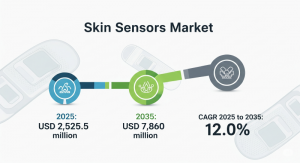Skin Sensors Market to Reach USD 7.86 Billion by 2035, Revolutionizing Non-Invasive Health Monitoring Solutions.
Rising demand for personalized health monitoring and wearable technology drives skin sensors market growth across global regions.
NEWARK, DE, UNITED STATES, August 13, 2025 /EINPresswire.com/ -- The global skin sensors market is poised to experience an extraordinary surge over the next decade, with projections indicating a market value of USD 7,860 million by 2035. This marks an impressive growth trajectory from USD 2,525.5 million in 2025, reflecting a remarkable 211.2% increase. The market’s rapid expansion, driven by innovations in non-invasive health tracking and wearable technology, is expected to achieve a Compound Annual Growth Rate (CAGR) of 12.0% during this period.
The skin sensors market is undergoing a paradigm shift, driven by increasing demand for real-time health monitoring solutions. These sensors, which are embedded in wearables, patches, and e-skin devices, provide manufacturers and consumers with the ability to monitor essential biomarkers such as hydration, glucose, and stress indicators without the need for invasive procedures.
This revolutionary technology addresses growing demands for non-invasive monitoring and personalized care. As consumers and healthcare professionals seek continuous, reliable insights into physiological data, skin sensors are gaining traction across a diverse range of applications, from chronic disease management to skin diagnostics and even athletic performance monitoring.
Uncovering the Growth Drivers
Non-Invasive Health Monitoring:
A major catalyst for the skin sensors market's growth is the increasing demand for non-invasive health monitoring devices. Traditional health tracking methods often involve bulky equipment or uncomfortable procedures. In contrast, skin sensors are lightweight, flexible, and comfortable, offering users a seamless experience for real-time biometric tracking, whether it be for chronic disease management, fitness, or skin health.
From monitoring hydration and glucose levels to tracking skin temperature and cortisol, skin sensors are poised to revolutionize the healthcare industry. The growth of chronic diseases, aging populations, and at-home healthcare solutions is accelerating the demand for such technologies.
Personalized Wellness and Skincare:
The wellness and skincare sectors are also major contributors to the skin sensors market’s expansion. The trend toward personalized care is gaining immense popularity, with consumers increasingly seeking customized skincare regimens based on their unique skin conditions. Skin sensors are playing a pivotal role in enabling personalized wellness solutions, particularly in regions like Asia-Pacific and North America.
Products that monitor hydration, pH levels, and oil content are driving new consumer-facing use cases beyond traditional medical applications. These advancements are creating an intersection between health and beauty, where continuous data-driven insights empower consumers to optimize their skincare routines and overall well-being.
Technological Advancements and Connectivity:
Advancements in flexible electronics, microfluidic technologies, and AI integration are further accelerating the development of skin sensors. Miniaturization of sensors and the use of hybrid materials like graphene and bio-compatible polymers have enhanced accuracy, durability, and comfort. This technology is enabling the development of ultra-thin, stretchable, and breathable devices that conform to the skin’s surface without causing discomfort.
Moreover, the seamless integration of skin sensors with wearables, mobile applications, and cloud platforms is enabling real-time data transmission and trend tracking. This connectivity, in turn, is fueling the rise of subscription-based wellness platforms and telehealth services.
Market Segmentation and Regional Insights
Growth in North America and Asia-Pacific:
North America remains a key market hub for skin sensors, driven by continued innovations in sensor technology and ongoing clinical trials. The region’s strong healthcare infrastructure and demand for advanced health monitoring solutions contribute to its leadership in the market. Moreover, the integration of AI-based platforms with skin sensors is becoming a critical enabler for data-driven decisions in healthcare, further boosting market growth.
Asia-Pacific is another promising growth region, benefiting from the growing base of digital health adopters and a robust manufacturing ecosystem. With increasing consumer interest in personalized healthcare solutions and wearable technology, the region is expected to see significant growth in skin sensor adoption, particularly in countries like China and India.
Rising Market Competition and Innovation:
The skin sensors market is becoming increasingly fragmented, with both established players and startups focusing on specialized use cases such as hydration tracking, UV detection, and sweat analytics. Companies like Philips Healthcare, which holds a 14.8% global market share, are well-positioned to dominate, thanks to their integration of skin sensors into broader health monitoring systems. Meanwhile, smaller players are capitalizing on niche markets such as personalized skincare, offering innovative, flexible, and biocompatible sensor technologies.
Challenges and Restraints
While the market is poised for growth, manufacturers face challenges such as data privacy concerns and regulatory hurdles. The collection of sensitive biometric data necessitates compliance with privacy regulations like GDPR and HIPAA, which can complicate product development and market launch. Additionally, regulatory approval from agencies such as the FDA and EMA requires rigorous clinical validation, creating time-to-market delays and cost barriers.
The Future of Skin Sensors: AI and Predictive Health
One of the most exciting trends driving the skin sensors market is the convergence with AI-driven wellness platforms. The combination of real-time biometric monitoring and cloud-based analytics enables predictive health insights, offering personalized feedback on hydration, stress, sleep quality, and metabolic health. These AI-powered insights are increasingly being integrated into consumer wellness ecosystems, offering tailored skincare routines and lifestyle recommendations. In clinical settings, AI algorithms are also being used to assist in early diagnosis, optimizing healthcare delivery.
Discover key market opportunities – Request your sample report now!
https://www.futuremarketinsights.com/reports/sample/rep-gb-22918
For more on their methodology and market coverage, visit
https://www.futuremarketinsights.com/about-us
Explore Related Insights
Vaporizers Market:
https://www.futuremarketinsights.com/reports/vaporizers-market
Digital Fabrication Inkjet Inks Market:
https://www.futuremarketinsights.com/reports/digital-fabrication-inkjet-inks-market
Hand Massager Market:
https://www.futuremarketinsights.com/reports/hand-massager-market
Mobile Stabilizer Market:
https://www.futuremarketinsights.com/reports/mobile-stabilizer-market
Screen Cleaner Market:
https://www.futuremarketinsights.com/reports/screen-cleaner-market
Editor’s Note:
This press release offers a comprehensive analysis of the global skin sensors market, providing manufacturers with critical insights into growth projections, technological advancements, and regional opportunities for expansion in the healthcare and wellness industries.
Rahul Singh
Future Market Insights Inc.
+1 347-918-3531
email us here
Legal Disclaimer:
EIN Presswire provides this news content "as is" without warranty of any kind. We do not accept any responsibility or liability for the accuracy, content, images, videos, licenses, completeness, legality, or reliability of the information contained in this article. If you have any complaints or copyright issues related to this article, kindly contact the author above.
Realty Photos Expands Services as Hurricane Season and Natural Disasters Highlight Need for Insurance Documentation
Cygnus Compliance Unveils Bold Rebrand Ahead of Five-Year Milestone, Signaling the Next Era of Growth and Impact
Award-Winning Author Stephen Eoannou Releases Third Novel 'After Pearl' Featuring Private Investigator Nicholas Bishop
Więcej ważnych informacji
 Jedynka Newserii
Jedynka Newserii

 Jedynka Newserii
Jedynka Newserii

Farmacja

Nowy pakiet farmaceutyczny ma wyrównać szanse pacjentów w całej Unii. W Polsce na niektóre leki czeka się ponad dwa lata dłużej niż w Niemczech
Jeszcze pod przewodnictwem Polski Rada UE uzgodniła stanowisko w sprawie pakietu farmaceutycznego – największej reformy prawa lekowego od 20 lat. Ma on skrócić różnice w dostępie do terapii między krajami członkowskimi, które dziś sięgają nawet dwóch–trzech lat. W Unii Europejskiej wciąż brakuje terapii na ponad 6 tys. chorób rzadkich, a niedobory obejmują również leki ratujące życie. Nowe przepisy mają zapewnić szybszy dostęp do leków, wzmocnić konkurencyjność branży oraz zabezpieczyć dostawy.
Handel
Wzrost wydobycia ropy naftowej nie wpłynie na spadek cen surowca. Kierowcy jesienią zapłacą więcej za olej napędowy

Sierpień jest trzecim z rzędu miesiącem, gdy osiem krajów OPEC+ zwiększa podaż ropy naftowej na globalnym rynku; we wrześniu nastąpi kolejna zwyżka. Kraje OPEC, zwłaszcza Arabia Saudyjska, chcą w ten sposób odzyskać udziały w rynku utracone na skutek zmniejszenia wydobycia od 2022 roku, głównie na rzecz amerykańskich producentów. Nie należy się jednak spodziewać spadku cen ropy, gdyż popyt powinien być wysoki, a pod znakiem zapytania stoi dostępność ropy z Rosji. Nie zmienia to faktu, że jesienią ceny paliw na stacjach zazwyczaj rosną, a w największym stopniu podwyżki dotyczyć będą diesla.
Nauka
Szacowanie rzeczywistej liczby użytkowników miast dużym wyzwaniem. Statystycy wykorzystują dane z nowoczesnych źródeł

Różnica między liczbą rezydentów a rzeczywistą liczbą osób codziennie przebywających w Warszawie może sięgać nawet niemal pół miliona. Rozbieżności są dostrzegalne przede wszystkim w dużych miastach i ich obszarach funkcjonalnych. Precyzyjne dane populacyjne są tymczasem niezbędne w kształtowaniu usług społecznych i zdrowotnych, edukacyjnych, opiekuńczych, a także w planowaniu inwestycji infrastrukturalnych. W statystyce coraz częściej dane z oficjalnych źródeł, takich jak Zakład Ubezpieczeń Społecznych, są uzupełniane o te pochodzące od operatorów sieci komórkowych czy kart płatniczych.
Partner serwisu
Szkolenia

Akademia Newserii
Akademia Newserii to projekt, w ramach którego najlepsi polscy dziennikarze biznesowi, giełdowi oraz lifestylowi, a także szkoleniowcy z wieloletnim doświadczeniem dzielą się swoją wiedzą nt. pracy z mediami.









.gif)

 |
| |
| |
|